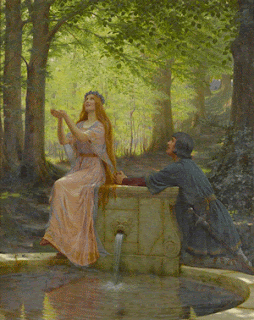
Pelleas and Melisande
"The score of Pelleas and Melisande by Debussy, heralds that which will lift man from the earthly to the celestial, from the mortal to the immortal. Once again the ways of the artist and healer are merging." - Corinne Heline
Pelléas et Mélisande, Op. 80 is a suite derived from incidental music by Gabriel Fauré for Maurice Maeterlinck's play of the same name.
 Fauré wrote this music for the London production of the original drama by Maurice Maeterlinck in 1898. To meet the tight deadline of the production, Fauré reused some earlier music from incomplete works and enlisted the help of his pupil Charles Koechlin, who orchestrated the music. Fauré later constructed a four-movement suite from the original theatre music, orchestrating the concert version himself. My favorite movement is the "Sicilienne" with its haunting melody that evokes the romantic mystery of music. The movement although in the traditionally sad key of G minor, represents the one moment of happiness shared by Pelléas and Mélisande.
Fauré wrote this music for the London production of the original drama by Maurice Maeterlinck in 1898. To meet the tight deadline of the production, Fauré reused some earlier music from incomplete works and enlisted the help of his pupil Charles Koechlin, who orchestrated the music. Fauré later constructed a four-movement suite from the original theatre music, orchestrating the concert version himself. My favorite movement is the "Sicilienne" with its haunting melody that evokes the romantic mystery of music. The movement although in the traditionally sad key of G minor, represents the one moment of happiness shared by Pelléas and Mélisande. The play that inspired Faure, Pelléas and Mélisande by Maurice Maeterlinck, is about the forbidden, doomed love of the title characters. It was first performed in 1893. The work was very popular. It was adapted as an opera by the composer Claude Debussy, and in addition to Faure it inspired both Arnold Schoenberg and Jean Sibelius. Faure was the first of the four composers to write music inspired by Maeterlinck's drama. Debussy, Schoenberg and Sibelius followed in the first decade of the 20th century.
Jean Sibelius also wrote incidental music in ten parts in 1905 , for Maurice Maeterlinck's 1893 drama Pelléas et Mélisande. Sibelius later on slightly rearranged the music into a nine movement suite, published as Op. 46, which became one of his most popular concert works.
While Maeterlink won the Nobel Prize for Literature in 1911 his symbolist plays are not as popular today. His masterpiece Pelleas and Melisande lives on more through the music it inspired.

2 comments:
I wish that I was more familiar with all these works. I just took a look at Pelleas and Melisande by Debussy on Youtube.
It reminds me that I need to continue my exploration of Opera, an art form that while my knowledge is sketchy of, I enjoy.
It is likely that I would begin by reading the play.
Brian,
Thanks for your comment. The "Sicilienne" by Faure has been a favorite of mine since college days. It is only in recent years that I encountered the opera and the other works inspired by Maeterlink's drama.
Post a Comment